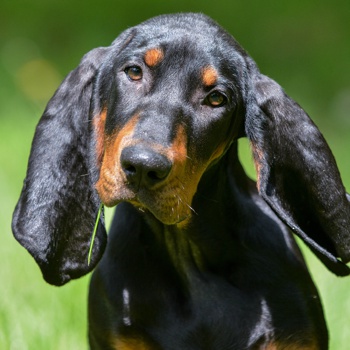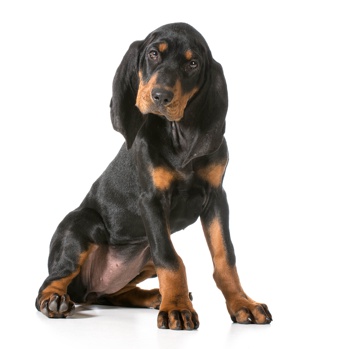How Big Do Black and Tan Coonhounds Get
Black and Tan Coonhound

The Black & Tan Coonhound belongs to the same family of dogs as the Bloodhound and Foxhound, and is a dog with a long ancestry dating back over 1,000 years. This large, handsome hound is a naughty but nice character, with a gentle nature but a wanderlust that can land him in trouble.
Anyone thinking of owning a Coonhound needs plenty of space, not just to exercise him but to ensure the nearest neighbours are out of earshot as he has a howling habit. He's also a pack animal, but willing to substitute people for other hounds and make the former his family. However, he dislikes being alone and easily develops separation anxiety when an owner goes to work, which can lead to howling.
- Jump to:
- About
- Appearance
- Character
- Training
- Health
- Exercise
- Grooming
About & History
The Black and Tan Coonhound is named for his coat colour and occupation. A hunting dog, his fine sense of smell is used to track racoons in his native America. His family tree goes back a thousand years to the now extinct Talbot Hound, once kept by the mountain people of the Ozarks and Smokey Mountains.
His other relatives include other scent-driven dogs, such as Foxhound and Bloodhound, with the breed as we see it today originating from the Southern US in the 1700s. There are actually six types of coonhound, of which the Black and Tan was the first to be officially recognised by the American Kennel Club back in 1945.
Once an immensely popular breed amongst smallholders and hunters, a change to city living, to which the Coonhound is ill-suited, has led to a decline in his numbers.
Appearance

Undeniably handsome, the distinctive Black and Tan Coonhound has long ears and an athletic body, with something of the look of a Doberman crossed with a Bloodhound about him. He has a well-developed nose, all the better for sniffing, and long velvety ears.
This large dog has a short dense coat, designed to protect him from the scratches and scrapes of rough woodland. He is mainly black with a tan muzzle, chest, paws, and eyebrows. Arguably the Coonhound's most distinctive feature is those large, droopy ears. He also has long legs, a well-proportioned body that is both sturdy but athletic, and a whip-like tail.
Character & Temperament
The Black and Tan Coonhound is all about scent. Bred as a tracking dog, at which he excels, he's never happier than nose down following a scent trail. This is also the reason behind one of his worst traits – taking off after a smell and disappearing over the horizon, stone-deaf to his owner's recall.
The Black and Tan Coonhound is a pack animal, loves the company of other hounds, and can tolerate living in an outside kennel. When welcomed into the home, he will forego canine companionship and substitute people instead. However, this means when his family go out to work he readily suffers from separation anxiety, which can manifest itself as howling. Indeed, the Black and Tan Coonhound loves the sound of his own voice and the slightest movement, such as a squirrel running up a tree, can trigger a long and noisy song.
The Coonhound also has a strong prey drive. This means he's ill suited to sharing accommodation with cats or other small pets, as he's liable to hunt them down. On the plus side, the Black and Tan Coonhound has an exceptionally gentle temperament and is unlikely to bite even when challenged, but, of course any dog should be supervised when around children. He's also emotionally slow to mature and retains puppyish behaviours to the age of three years, which makes for a reliable and safe family dog.
Trainability

The Black and Tan Coonhound is not considered an ideal dog for the first time dog owner. Whilst he is gentle and reliable, he is also very stubborn. When he picks up a scent he becomes deaf to his owner, and this coupled with a tendency to roam makes him difficult to train. Indeed, owners are well advised to keep their dog on the lead when out as the latter is likely to disappear at the earliest opportunity.
Health
The Coonhound's average life expectancy is around 10-12 years, in common with other large breeds. Happily, they are a relatively healthy dog with just a handful of conditions linked to the breed.
Cataracts
The lens within the eye is normally clear, to allow the uninterrupted passage of light onto the retina. When the lens becomes cloudy, impeding light reaching the back of the eye, this is known as a cataract.
Black and Tan Coonhounds are prone to developing cataracts in later life. When the signs are spotted early, cataracts can be correct by a specialist veterinary ophthalmologist.
Ectropion
This is an anatomical problem affecting the lower eyelids which are over-sized and turn out to expose the delicate mucous membrane lining. Mild cases need no action but extreme out-turning can lead to discomfort due to excessive drying of the eye. Surgical correction is relatively simple, and involves removing a portion of the eyelid so that it fits flush to the cornea.
Hip Dysplasia
The hip joint is a ball and socket joint, with smooth movement depending on the ball at the top of the thigh bone (femur) fitting snuggly into the socket (the acetabulum of the pelvis). Hip dysplasia refers to poor hip anatomy as a result of uneven growth of the hip bone.
Instead of a smooth motion when the dog takes a step, the hip grinds in the socket causing inflammation and pain. In addition, continued insult to the joint leads to premature arthritis, further adding to the dog's problems.
Sadly, hip dysplasia can be disabling and cause symptoms in relatively young dogs. Mild cases can be managed with medical therapy, such as pain-relieving anti-inflammatory medications. However, severe cases may need total hip replacement surgery to regain their mobility.
Hypothyroidism
The thyroid glands produce hormones that govern the dog's metabolic rate. Hypothyroidism refers to a lack or deficiency of thyroid hormones, which in turn means the dog's metabolism runs too slowly.
The condition is typified by a lack of energy, weight gain, and a poor coat. Happily, once recognised and confirmed, hypothyroidism is easily treated with a simple daily supplement of thyroid hormone.
Exercise and Activity Levels
His physique, mind-set, and history all highlight that the Black and Tan Coonhound is an active dog that loves to follow a scent all day long. This is reflected in his need to have plentiful exercise, but, of course, this can be a problem for a dog that is unreliable off-leash.
One compromise is that the Coonhound does make a great running or jogging partner for active owners. But, be warned, if you don't meet his requirements for exercise he will amuse himself by howling, digging, or chewing. The Coonhound also has a tendency to become overweight if he doesn't get enough exercise.
Grooming
The Black and Tan Coonhound has a short dense coat that shines like a seal in certain lights. He doesn't require any professional grooming and a slick over with a rubber grooming tool two to three times a week helps to spread natural conditioning oils.
The downside of his short coat is that he is a heavy shedder. Be prepared for soft furnishing to be permanently covered in Coonhound hair if he is a house dog.
Famous Black and Tan Coonhounds
If you like dogs on the big screen, then the Disney's 1999 movie The Duke is about a Black and Tan Coonhound that inherits a dukedom.
Additionally, back in the early 19th century, Thomas Jefferson, the 3rd US President, was a big Black and Tan Coonhound fan. Jefferson is credited with the quote: "How one deals with their Coonhound's slobber is the most telling way of how one deals with everyday problems; after all he is your best friend."
Bringing things up to date, you can feel the love for Coonhounds at #BlackandTanCoonhounds on Instagram and on Facebook at the American Black and Tan Coonhound group.
Cross-Breeds
All is not as it seems! Whilst there are hybrids known as the 'mini coonhound', in fact, these dogs have no coonhound blood in them! Instead, they are a blend of Italian Greyhounds, Miniature Pinschers, and Chihuahuas that has created a small dog with a look of the Black and Tan Coonhound about it.
User comments
There are no user comments for this listing.
How Big Do Black and Tan Coonhounds Get
Source: https://www.dogzone.com/breeds/black-and-tan-coonhound/